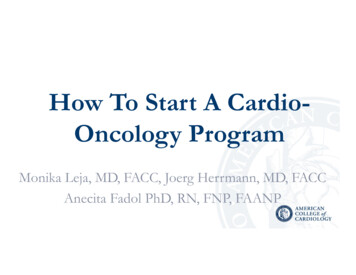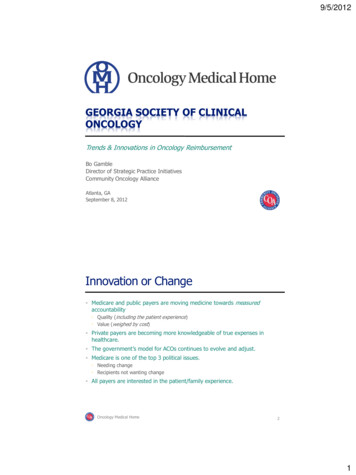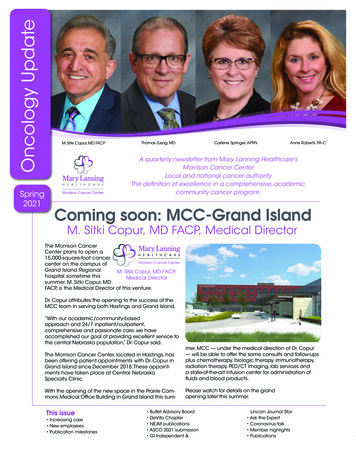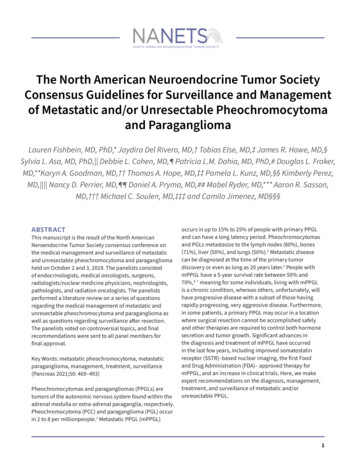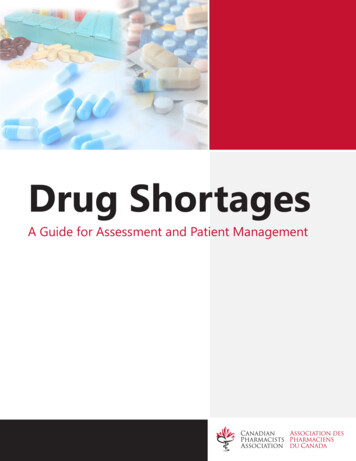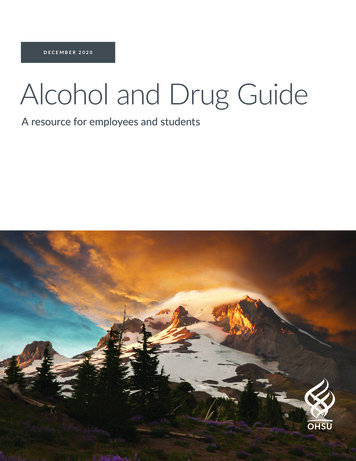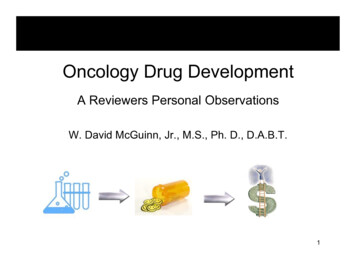
Transcription
Oncology Drug DevelopmentA Reviewers Personal ObservationsW. David McGuinn, Jr., M.S., Ph. D., D.A.B.T.1
They Make Me Say This Disclaimer– This presentation is not an official FDA guidance orpolicy statement. I do not intend to convey officialsupport or endorsement by the FDA and you shouldnot infer any such support or endorsement. Financial Interest Statement– I have no financial interest in any of the topics I ampresenting. If I did they would fire me. My comments may not necessarily pertain tobiological compounds2
Drug Development D 500,000compoundsMarketNDA1 drug
IND – Investigational New Drug A FDA process that regulates clinical drug development A permissive process, not an approval process The IND is initiated with the submission of all initial in vitroand in vivo information necessary to support the trials ofthe drug in humans for the first time Whether the compound is reasonably safe for initial usein humans Whether biological plausibility of the compound isdemonstrated4
Clinical Development Phase 1 trial – first study in humans–Determines pharmacological dose and safetyparameters, and sometimes PK parameters–PK may drive escalation Phase 2 trial – initial exploration of efficacy EOP2 – end of Phase 2–Consultation with FDA on future development Phase 3 trial – randomized, controlled (usually) study toprovide statistical confirmation of safety and efficacy5
Approval Package NDA – New Drug Application–Complete package of clinical and nonclinicalinformation submitted to the FDA to supportapproval of a new drug for marketing and sale–There are specific requirements for non-clinicalstudies that must be included in this packagedepending on the drug indication6
FDA Purview What we do not regulate– Drugs that have NO component that crossesstate lines– Herbs, natural products (Hatch Act) What we do regulate– Any therapy the components of which aremarketed across state lines– Herbs and natural products when the dosegreatly exceeds traditional well establishedones7
Drug Discovery Not monitored by the FDA Mechanism of Action NOT always necessary– Products that show pharmacological activity prior tothe characterization of their mechanism– Drugs with unpredicted secondary pharmacology e.g. sildenafil– You do need to demonstrate biological plausibility– Plausible – Kinase inhibition, traditional medicines– Implausible – Homeopathy, Aluminum foil hats In many cases it is impossible to establish a true causallink between in-vitro results (e.g. inhibition) and clinicalefficacy– e.g. Many natural products8
But Characterization of the pharmacology helps inthe design of the toxicology studies– Without a binding constant you cannot makeestimates about required plasma concentrations If your feasible Cmax is 10 fold lower than your bindingconstant. (e.g. biological plausibility)– Without characterization of the distribution of thetarget receptor you cannot predict secondarypharmacologies or toxicities Cardiac toxicities of tyrosine kinase inhibitors PET Scan for binding (see M3)9
Does the drug have otherpharmacological targets? Example: a new drug interacted with thefollowing pharmacological targets in astandard set of assays––––A2A receptor, IC50 3 µMadenosine A3 receptor, IC50 7 µMcentral benzodiazepine receptor, IC50 2 µMP2Y purinergic receptor, IC50 10 µM BUT10
Correlated Toxicities Adenosine A2A receptor when activated increases blood flow in thecoronary arteries via vasodilatation and is involved in respiratoryrhythmadenosine A3 receptor is also involved in cardiac regulationcentral benzodiazepine receptor - muscle relaxation, sedation, antiseizureP2Y purinergic receptor G-protein coupled receptors with all kinds ofactivity depending on tissueRats had convulsions at high dosesRats became hypoactive after a single dose and had decreasedrespiratory rateDogs had an increase in arterial pressure and heart rateAll at Cmax values above the IC50 values for these receptors11
Or How about some Enzymology I almost never see this – Why?– Is anyone around trained to do this work?– Does anyone understands kinetics of molecularinteraction?– Can anyone interpret the kinetics relative to the invivo situation?– Is there good assay for the activity of the compound?– Is the mechanism too complicated?– If we did it would we like what we found?– BF Krippendorff et al. Nonlinear pharmacokinetics of therapeuticproteins resulting from receptor mediated endocytosisPharmacokinet Pharmacodyn (2009) 36:239–26012
Reversible Diffusion of DFP across the RBCmembrane1.61.20.80.4005001000time (sec)1500
Whatdo youdoNext?Try theNewDrug inanAnimalModel?
Consultation amongToxicologists, Chemists &Physicians is Essential The schedule that is planned clinically should bethe schedule you propose for toxicology studies– This will depend on the pharmacology The route should be the same (to get similar PK) The formulation should be as close to the finalformulation as possible (again because of PK) Get all disciplines around a table and talk aboutdevelopment at every stage– Toxicologists, physicians, chemists, clinicalpharmacologists15
In Vivo Testing for Activity By this I mean tumor implant studies Don’t get carried away We do not review most of them, these test arefor your benefit They have almost no predictive value for tumortype and are questionable for predicting clinicalschedule Everything cures cancer in the mouse To make my point I searched PubMed for– “Xenograft and mouse and blueberries”16
Suppression of proliferation and tumor growth of human lung carcinoma cells by C3G in vitroand in vivo.Ding M et al. J. Biol. Chem. 2006;281:17359-17368 2006 by American Society for Biochemistry and Molecular Biology
TK and PK Can Teach You SoMuch In vitro metabolism Plasma protein binding data for animals andhumans– Essential to understand exposure and potentialbinding at the active site systemic exposure data in the species used forrepeated-dose toxicity studies– Can be done in conjunction with the multi-dose animalstudies– Studies can demonstrate exposure in cases wherethere is little or no toxicity associated with the drug (ICH S3A, Ref. 7)18
Kinetics Can Greatly Aid Doseand Species SelectionDose vs AUC in Male and Female Dogs on the First and LastDay of Dosing3025Males day 1AUC 0-24 hours h*!M20Females day 1Males last dose dayFemales last dose day151050050100-5Dose mg/m 215020025019
Kinetics Can AnticipateProblems in Reaching an DoseDose vs C m ax in Male and Female Dogs12Cmax !M10864Male2Female005001000150020002500Dose mg/m 220
Drug-Drug Interactions Treatment in Oncology is almost always polytherapy– Patients are sick and require lots of support A Drug-Drug interaction will almost never killyour drug if it can anticipated and controlled Not always well predicted by animal studies– Rats do not have a Cytochrome P450 3A4 equivalent In vitro testing for inhibition and metabolismmuch simpler than it use to be Testing for induction can be part of the multidose studies21
Safety Pharmacology Studies Cardiovascular – hERG, Purkinje Fibers, ECG(telemetry)– ECG monitoring time is critical– Ion Channel related or chronic cardiac damage? Respiratory systems – can be done with in vivocardiovascular studies CNS – Irwin battery and others Can be combined with toxicology studies!!– Do this – it minimizes animal use– Not essential for entry into phase I with oncology drugs For normal volunteers the rules are the same as M322
When is an ECG not Enough Most drugs that exhibit cardiac toxicity do so bycausing ion channel blockade Not the case with most oncology drugs– They are frequently negative in the hERG assay– And frequently show no changes in the ECG after asingle dose even at Cmax But they can cause long term damage– Mitochondria inhibitors– Cardiac remodeling (RNA, chaperonins, proteintransport)– HDAC inhibitors23
Do Not Discount the Severity ofToxicities Cancer drugs are almost always escalated to aMaximum Tolerated Dose What toxicity do you anticipate will be DoseLimiting? Can the toxicity be monitored Clinically? Is the toxicity reversible in the animals? Possible examples of unacceptable Phase 1toxicities– Seizures, irreversible ataxia, irreversible cardiacdamage?24
Don’t Kill a Drug that Don’t need aKilling Oncologists are accustomed to dealing withtoxicities A toxicity seen in a non-clinical study shouldrarely kill an oncology drug– If you have a troublesome toxicity don’t diminish it– Characterize it as well as you can– If possible determine the mechanism A thorough characterization will make it easier tomanage the toxicity clinically It will also help to make the Package Insertinformative and comprehensive25
26
Don’t do too Much Work! Decide early if you are going to move to non-lifethreatening conditions – the rules start to change For patients with curable disease the rules movetoward M3 For patients with extended prognosis (indolentdisease) you may need longer studies Do only studies needed to support the indicationand avoid redundant durations– For example doing a 6 month study plus a 9 monthstudy is almost always unnecessary27
Reproductive Toxicology Embryofetal Toxicity studies should be available whenthe NDA is submitted Are not considered essential to support clinical trialsintended for the treatment of patients with advancedcancer Are not considered essential for the purpose ofmarketing applications for pharmaceuticals that aregenotoxic and target rapidly dividing cells or belong toa class that has been well characterized as causingdevelopmental toxicity28
Combination Drugs The Combination Rule– Both drugs need to contribute to the clinicalefficacy– If you plan to give a new drug with a wellestablished cancer drug, combination studiesare almost never needed This class includes situations where aprimary drug is given in combination with adrug that modifies its metabolism orelimination29
Photodynamic Therapy (PDT) You give the patient a compound that absorbslight– Most are Porphyrin derivatives (think Heme)– The drug partitions to tissue by phagocytosis– Many studies have tried to show greater uptake intumors– You irradiate the tissue (tumor) with an activatingwavelength– The PDT drug forms a radical that propagatesthrough the tissue causing necrosis and apoptosis30
Conjugates Usually refers to an antibody conjugated to a cytotoxin Is the conjugate stable or is it hydrolyzed to release thecytotoxin in vivo? Is the cytotoxin (sans antibody) well characterized? Is the cytotoxin a genotoxin? Is there a linker molecule? Is the distribution of the conjugated molecule significantlydifferent from that of the cytotoxin?– Almost certainly What toxicity studies are needed to characterize thesemolecules?31
Make a Point to Correlate the ClinicalToxicities with the Non-ClinicalClinicalIncidenceN 207(%)Injection site adverse event35RatInjection site damageWeight loss males - chronic,Weight increasefemales - chronicMonkeyMouseinjection site damageinjection site damageWeight increase - maleacute low doseWeight loss males chronic,Weight increasefemales chronicWeight increase9Fatigue3HypotensionChills5inflammatory responseHypothermia,inflammatoryresponseHot Flash26decreased testosteronedecreased testosteroneHypertension6Hypotensioncold extremities - acuteInflammatoryresponseYesYes6Changes in Alkalinephosphatase anddeoxypyridinolineChanges in Alkalinephosphatase anddeoxypyridinolineInflammation of thespinal cordArthralgia5Changes in Alkalinephosphatase anddeoxypyridinolineChanges in Alkalinephosphatase anddeoxypyridinolineUrinary tract infection5Increased urine outputIncreased urinary pH acuteConstipation5Slowed GI transit timeBack painDogYes32
How We Look At ToxicitiesParameterMales **% .9%-66.7%-66.7%APIT3021.7-4.1%-6.5%-7.8%33
The Guiding Principles Concern for the patient is paramount Just do good Science We are concerned with efficient developmentbecause– It can speed approval– It limits the use of animals– We do not want unnecessary studies34
Pre-IND meeting with the FDA Brief outline of– Completed and proposed pharmacology– Completed and proposed toxicology– Completed and proposed chemistry– Proposed Clinical Phase I development You need not have all the information to supportthe clinical study at the time of the Pre-IND You may be proposing to do more than necessaryto support the clinical study (Yes we will tell you)35
Ideal Dose Levels inToxicology Studies Low dose should determine NOAEL– non-life threatening indications High dose should determine an MTD or limit dose– To determine the spectrum of toxicities Mid dose should show some toxicityThus, 3 doses would ideally determine the top, middle and bottom ofthe dose response curve– The use of 3 dose groups is arbitrary.– Using more dose levels helps define the dose response curveDecade doses will almost never do this (1, 10, 100)– The high dose will cause too much toxicity– Or the low dose will be useless as it is below the NOAEL– Toxic dose response curves rarely span more than 10 times thehighest non-toxic dose36
Examples of the Effect ofToxicology Studies onClinicalPhase1Assumptions Small Molecule Effective pharmacological dose eventuallydetermined to be 6 mg/m2 Eight Subjects per Dose Level During Escalation– six receive active drug, two controls percohort– Dose doubling between cohorts Dose scales 1:1 on a mg/m2 basis37
Example 1 - Non-Clinical LogDoses Non-clinical Rodent Study Results 0.1 mg/m2 1 mg/m2 10 mg/m2No Clinical SignsNOAELObserved adverse effects Clinical Consequences:– Starting dose 1/10th the NOAEL 0.1 mg/m2– Escalation requires 7 levels or 56 Subjects toreach pharmacological dose (6 mg/m2)38
Only 4 fold between little toxicity anddeathDose vs AUC in Male and Female Dogs on the First and LastDay of Dosing3025Males day 1AUC 0-24 hours h*!M20Females day 1Males last dose dayFemales last dose day151050050100-5Dose mg/m 2150200250
Example 2 - Non-Clinical Doses Closer toTrue NOAEL Non-Clinical Rodent Study Results 1 mg/m25 mg/m210 mg/m215 mg/m2no clinical signsNOAELObserved Minor Adverse EffectsObvious toxicity Clinical Consequences:– Starting dose is 1/10th the NOAEL 0.5 mg/m2– Escalation takes only 5 levels or 40 Subjects– Toxic dose response curve is well defined40
Consequences of DoseSelection for ToxicologyStudiesFor each factor of 10 you miss the true NOAEL on thelow side you add an extra 4 escalation steps to Phase 1– This assumes dose doubling, it will result in moresteps with more cautious escalation– In oncology each patient costs 15,000 to 20,000 ora total of 240,000 to 320000 extra in our exampleabove– This does not consider the added time ofdevelopment– Talk with the physicians and figure out if you arereally saving money by skimping on dose rangefinding or excluding that extra dose group from thetoxicology study41
Conclusion Non-clinical drug development is a scientific process– It is not about checking off boxes for a regulatory agency The process is sequential– Not all development needs to be done up front– This saves time, money & animals if early clinical trials fail toshow efficacy The process is flexible– It allows for the development of new drugs with a variety ofdifferent mechanisms The process is multi-disciplinary– Talk to your physicians, chemists and clinical pharmacologists When in doubt talk to the regulatory agency– They really do want good new drugs approved42
References All ICH guidelines – http://www.ich.org/cache/compo/502-272-1.html National Center for Replacement, Refinement and Reduction of Animals in Research– http://www.nc3rs.org.uk/ Johns Hopkins Center for Alternatives to Animal Testing – http://caat.jhsph.edu/ Camilla Buoen, Ole J. Bjerrum and Mikael S. Thomsen. How First-Time-in-HumanStudies Are Being Performed: A Survey of Phase I Dose-Escalation Trials in HealthyVolunteers Published Between 1995 and 2004. J. Clin. Pharmacol. 2005; 45; 1123 WT Robinson. Innovative Early Development Regulatory Approaches: expIND,expCTA, Microdosing. Nature, February 2008, 83(2):358-360. Graham Lappin & R Colin Garner, The utility of microdosing over the past 5 years,Expert Opin. Drug Metab. Toxicol. (2008) 4(12):1499-1506 Graham Lappin and R. Colin Garner, Big physics, small doses: the use of AMS andPET in human microdosing of development drugs. Nature Reviews, Drug Discovery,March 2003, 2:233-240.44
FDA Guidance rmation/Guidances/default.htm– Estimating the Maximum Safe Starting Dose in Initial Clinical Trials forTherapeutics in Adult Healthy Volunteers. July 2005.– Content and Format of INDs for Phase 1 Studies of Drugs, Including WellCharacterized, Therapeutic, Biotechnology-Derived Products October 2000– Exploratory IND Studies, January 2006– Format and Content of the Nonclinical Pharmacology/Toxicology Section of anApplication, February 1987– Immunotoxicology Evaluation of Investigational New Drugs Integration of StudyResults to Assess Concerns about Human Reproductive and DevelopmentalToxicities. November 2001– Nonclinical Safety Evaluation of Drug or Biologic Combinations March 2006– Nonclinical Safety Evaluation of Reformulated Drug Products and ProductsIntended for Administration by an Alternate Route. March 200845
FDA Guidance Cont.– Photosafety Testing. May 2003– Recommended Approaches to Integration of Genetic Toxicology Study Results.March 2006– Reference Guide for the Nonclinical Toxicity Studies of Antivial Drugs Indicatedfor the Treatment of N/A Non-Life Threatening Disease Evaluation of DrugToxicity Prior to Phase I Clinical Studies. March 1998– Safety Testing of Drug Metabolites February 2008– Single Dose Acute Toxicity Testing for Pharmaceuticals August 2006– Statistical Aspects of the Design, Analysis, and Interpretation of Chronic RodentCarcinogenicity Studies of Pharmaceuticals. May 2001– Nonclinical Safety Evaluation of Pediatric Drug Products. February 2006– Nonclinical Studies for the Safety Evaluation of Pharmaceutical Excipients. May200546
Drug-Drug Interactions Treatment in Oncology is almost always poly-therapy - Patients are sick and require lots of support A Drug-Drug interaction will almost never kill your drug if it can anticipated and controlled Not always well predicted by animal studies - Rats do not have a Cytochrome P450 3A4 equivalent
